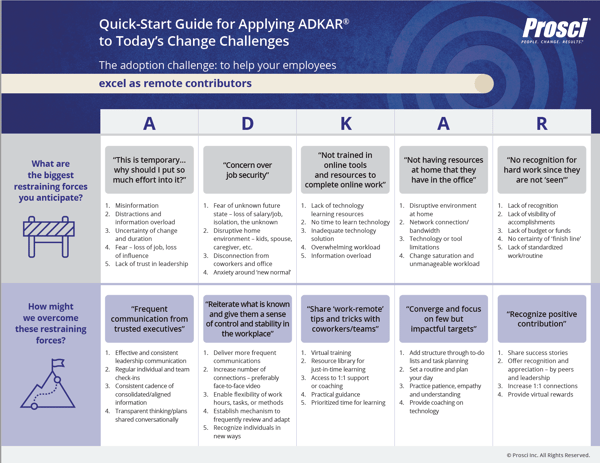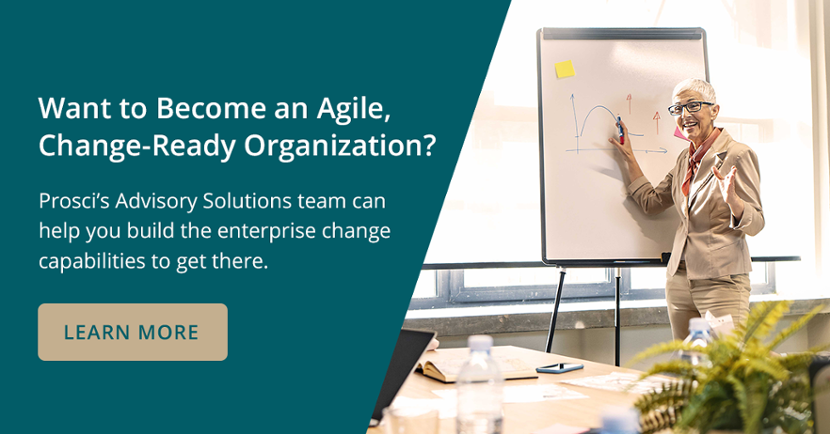How to Manage Change in a Crisis With No Time to Plan
4 Mins
Updated: March 14, 2024
Published: May 20, 2020

The constant influx of new information about COVID-19 is causing change management practitioners to reassess and course correct, sometimes daily. This makes traditional planning approaches less useful at a time when adoption and usage are critical for people as well as organizations. Fortunately, you don’t need to throw out process, plans or structure—you just need to adapt them properly.
Aiming ADKAR at Today's crisis
A friend’s organization recently secured a contract to provide a COVID-19 response service. They had three days to implement a new business model involving thousands of employees. Three days! In crisis situations like this, what can you do with so little time to plan? How can you move forward when new information continually requires you to rethink yesterday’s plan?
The simplest, quickest, and most effective tool we have as change practitioners is still the ADKAR Model. In a recent Prosci webinar, Tim Creasey shared how you can apply the model to a few crisis-related changes by considering the elements of ADKAR, along with the restraining and driving forces that impact your change management effort.
The activity Tim presented enables you to generate a quick list of tactics to support people to adopt and use the change. Doing this exercise with a team takes 30 minutes and will yield a basic ADKAR Canvas to get your change off to a great start. Prosci also created a set of quick-start guides, which you can use for reference as you work through your own specific change challenges.

Prosci ADKAR Quick-Start Guides
Highly Adaptive Decisions
When we implement a technical change rapidly―before we’ve had adequate time to prepare, equip and support people―we need to shift to supporting people during and after the implementation. This means your change management activities must be highly responsive to what is needed now, in the moment, to achieve adoption and usage.This is where Adaptive Action comes in. I was first introduced to the concept by Glenda Eoyang, author of Adaptive Action: Leveraging Uncertainty in Your Organization. Adaptive Action is an elegantly simple, repeatable process that enables you to reflect on the current situation and arrive at the most effective, next action.
Adaptive Action involves asking and answering three simple questions:
- What?
- So what?
- Now what?
What? helps you to reflect on your current situation and see clearly beyond any confusion. So what? helps you make meaning and draw conclusions about strengths, opportunities and options. Now what? helps you act. Adaptive Action isn’t about the time-consuming search for the perfect or right answer. Rather, it’s about making progress with the best information you have at the time. This simple thinking process encourages you to move rapidly from conceiving ideas to trying them, and then learning and refining as you go.
Rapid Crisis Response
When combined, the ADKAR Model and Adaptive Action create a powerful and nimble change process. As an example, consider the adoption challenge of helping individuals excel as remote contributors during the COVID-19 crisis.
Like many organizations, yours rapidly shifted to working from home. Now, weeks into the change, people are struggling, expressing frustration, and teams are not meeting operational targets. You know you must do more to support people to become proficient with the change.
Start with What? Complete a Prosci Business Change Assessment to identify the barrier point in the change. Remember, a barrier point is the first ADKAR element with a score of 3 or below, which means it impedes change progress. Think of it as the root cause of why your change feels stuck. The barrier point tells you where to focus our attention to make progress.
For example, an ADKAR assessment that reveals that many employees have a barrier point at Knowledge means they don’t know how to change. Note that it is essential to identify the correct barrier points. It can be very frustrating for people, and ineffective for the initiative, if your responses and adjustments focus on the wrong ADKAR element.
The next step is to reflect on So what? After all the salient observations have been collected, you must make sense of what is happening. This is where you consider the opportunities that exist.
Let's say your organization doesn’t have standard platforms for remote work. Each department has decided to use different tools. People are struggling to collaborate with other teams on different technology platforms and they're overwhelmed by having to learn multiple platforms at once. While training is offered, people can’t keep up. They don’t have the capacity to participate in multiple training sessions.
Finally, consider Now what? This step moves you to action. It helps you get “unstuck” by determining the next, best action you can take to support people. If you get it right, fantastic! If you notice that people are still struggling, you can simply begin the Adaptive Action process again. When you begin again, check your past assumption and start with what you know about your current situation.
Using the remote-work example, you could identify the groups that have the highest collaboration needs. Then, agree on a common platform to minimize the need to train on multiple platforms. Finally, provide a simple, visual job aid for each technology platform which offers just-in-time learning support.
| What? |
|
What happened? What do you notice? What facts or observations stood out? What new information do you have? |
| So what? |
|
What conclusions are emerging? What does it mean to you and to others? What is the opportunity? What adjustments might be required? What options exist? |
| Now what? |
|
What is the next, best action to take? How might we need to adapt the ways we are preparing, equipping and supporting people? Once you decide, take action. |
Combining the ADKAR Model with the Adaptive Action process is a great way to leverage two simple and powerful tools that are uniquely suited to addressing today’s change challenges. I encourage you to use these tools to involve people directly in the change process. You may not have much to say in what is changing or when, but you can maximize their involvement in how you will change. You can start a conversation about the driving forces for each ADKAR element. You can also engage groups in an activity to reflect on how the change is going and tap into their ideas about what they need to be successful.
Better, Faster Change During Crisis
I love a good plan. For me, a plan brings a sense of comfort, certainty and control. Under normal circumstances, a fully informed and carefully thought-out change management plan is best. But when a crisis such as COVID-19 presents urgent, emergent and high-stakes changes, you need to make faster, more nimble decisions. When you have no time to plan, combining the ADKAR Model with Adaptive Action offers a powerful tool for managing change quickly and effectively.


